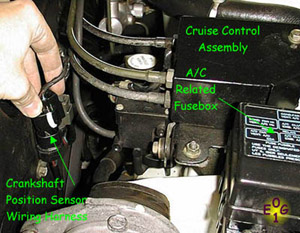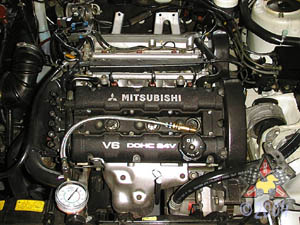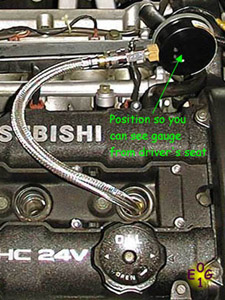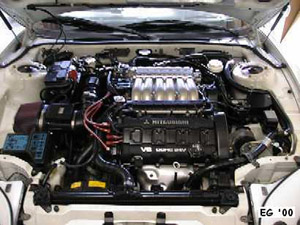|

|
Disconnect the Crankshaft Position Sensor Wiring Harness
|
|
|

|
|
|
Disconnecting this harness will cause the ECU to disable the
ignition system and to disable the fuel injectors. Then you can
safely turn the engine over with the starter to check compression.
|
|

|
Cover Spark Plug Holes and Crank Engine
|
|
|
Cover the spark plug holes with shop towels (don't stick them INTO the holes
as they will be shot out of you engine bay like a cannon. Ask me how I know :-)
Crank the engine over a few times (5 seconds or so), and examine the towels
for any debris or strange material. Be aware that if you have stuff (oil,
coolant, fuel, etc.) in your engine due to some engine malfunction, this stuff
WILL be shot out of your spark plug holes. At the very least that will make a
mess; it could also injure you or someone else. Be careful!
|
|

|
Check Cylinder Compression
|
|
|


|
|
|
Place the long-reach adapter onto your compression gauge. If you have
multiple adapters, examine them and use the one that is closest to
the length of the threads on your spark plugs.
Thread the compression gauge into the spark plug hole of the cylinder
you wish to test. Make sure the connection is snug. If you were doing
this with the plenum and throttle body attached (front bank only), then you would
hold the accelerator pedal on the floor to open the throttle body. Since the
plenum and throttle body are off the car at this point, you don't have to
mess with the accelerator pedal. Then turn the
engine over (by turning the ignition key to "Start" with the clutch pedal
depressed) until the needle on the gauge stops moving (it may take
10-15 compression strokes). Record this value and repeat for
each of the other 5 cylinders. Stock compression for a NA engine (10:1)
is 185psi with a lower limit of 139psi. Stock compression for a turbo
engine (8:1) is 156psi with a lower limit of 115psi. Further, in either
engine, there should be no more than 14psi between the HIGHEST and LOWEST
cylinder compression readings. Note that compression readings should
be taken with a WARM engine, which means you'll have to do the above
steps with rather hot parts - mechanics' gloves help. For reference, my engine
reads about 10-15psi LOW when cold when compared to a warm (operating temperature)
engine.Note: if you have a cylinder that has LOW compression, you can
try squirting a small amount (a mL or two) of engine oil into that cylinder's
spark plug hole and rechecking compression. If the compression is better the second time,
that could indicate worn rings on that cylinder (oil helps provide a better seal).
|
|

|
Reset Your ECU
|
|
|
This step is necessary to erase the engine check code stored in the ECU
since you turned the car on with the CPS disconnected. Using your 8mm
wrench (or whatever size for your non-stock terminals), disconnect
the negative terminal of the battery for 10 seconds or more. Then reconnect
the negative terminal.
|



